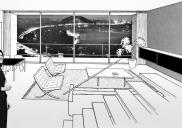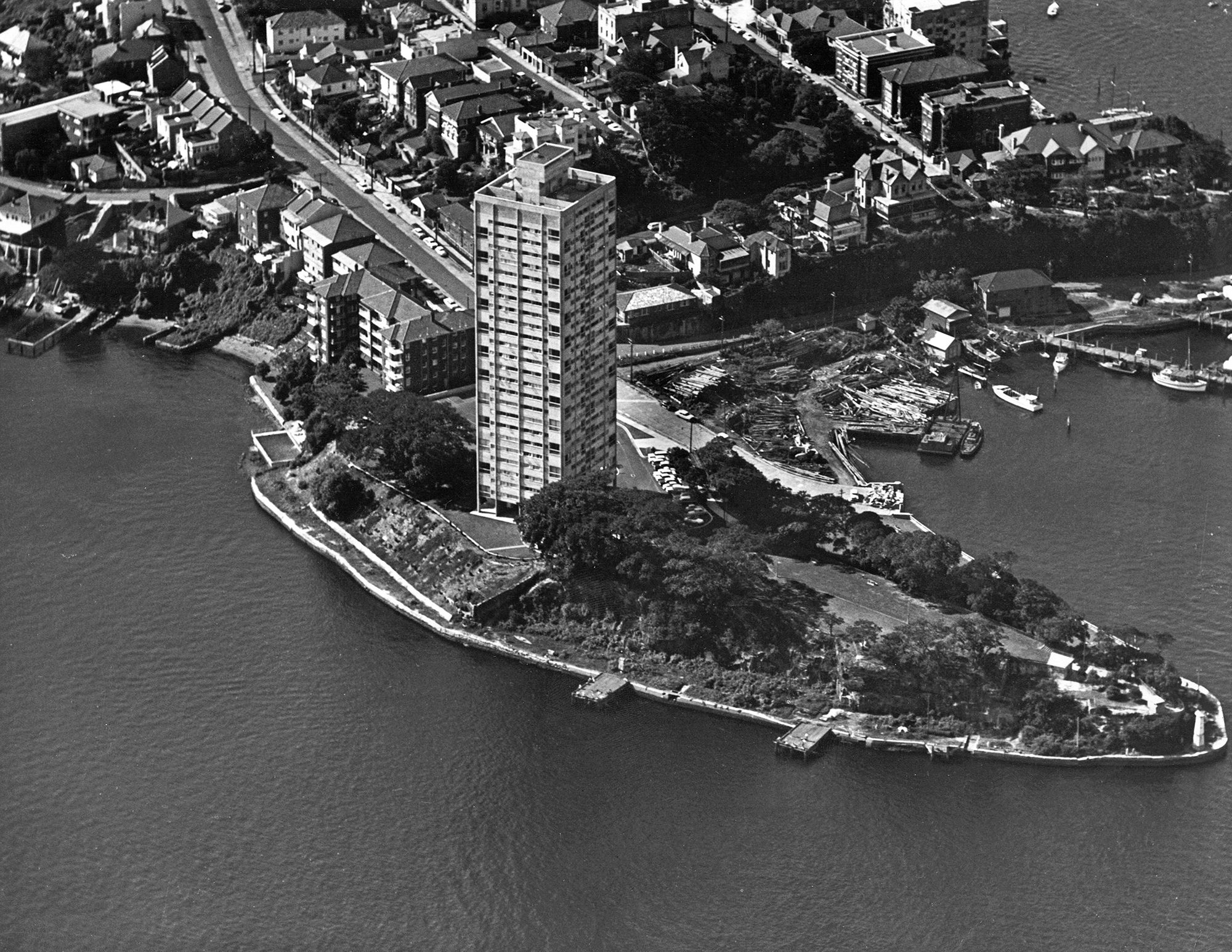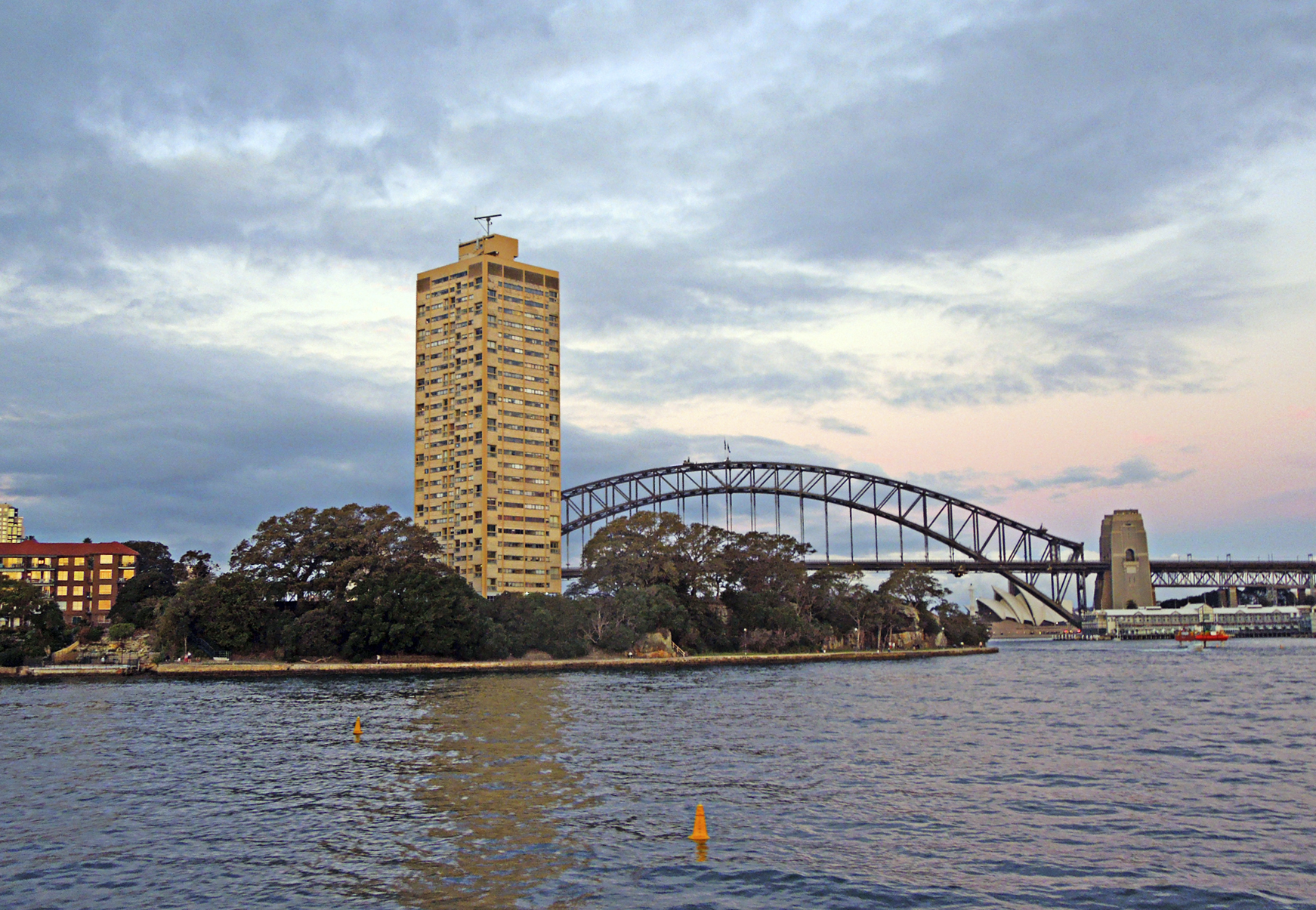|
‘Blues Point Tower’Harry Seidler's ‘Blues Point Tower’ was welcomed when it was planned in the late 1950s but, years later, prompted strong opinions from Sydneysiders.Its fame has stemmed from its size and location - a 25 storey apartment block standing starkly on a harbour peninsula - so that many have wondered at the thinking and process that led to its construction. The story of 'Blues Point Tower' is, in fact, bound up with the development of post-war planning ideology and heritage consciousness in Sydney, and our changing attitude to Sydney Harbour. That story began with the zoning of the peninsula as industrial land by the Cumberland County Council, the State Government body created in 1945 to co-ordinate planning across Sydney's local government areas. The zoning accorded with the existing industrial use of much of the waterfront around the point and in nearby Berrys and Lavender Bays, but did not please North Sydney Council and many local residents who thought a residential zoning more appropriate. The local McMahons Point and Lavender Bay Progress Association invited a group of young architects led by Harry Seidler to devise a conceptual scheme that demonstrated the benefits of residential zoning. Having trained and worked overseas with pre-eminent Modernist architects Walter Gropius, Marcel Breuer and Oscar Nieyemier, Seidler’s goal was to bring rationality to residential planning on Sydney Harbour – a waterway he thought should be better appreciated for its beauty and one he saw despoiled by waterfront industry, such as the timber yard and boatsheds that lined the local bays. Critical of Sydney's suburban 'sprawl' Seidler argued for urban consolidation in well-designed and well-planned flats: ‘Sydney’s problem is one of underdensities rather than overdensities’. The invitation from the Progress Association was an opportunity to articulate these ideas. The architects worked without fee from a local empty shop, designing and building a model that demonstrated how the site might be redeveloped with planned high rise. When made public the concept was received with enthusiasm by the press and state and local government. It was seen as a means of saving the Harbour from further industrial despoliation and, indeed, succeeded in stopping the industrial rezoning of the area. Residential zoning was gazetted in October 1958. The booklet in which the architects laid out their case was called Urban Redevelopment Concerns You! At Blues Point it was possible to increase the population from 3,500 to 15,000 while creating open space between buildings. The concept comprised eight towers on the rise above Berrys Bay, at least 17 large slab blocks and 17 smaller maisonette blocks with other low rise facilities and a great deal of open space in between. Maximising the number of people who could be accommodated in this prime location, while providing them with views and open space, would necessitate the complete demolition of all existing structures. Such an uncompromising ‘masterplanned’ approach accorded with the thinking of Modernist planning, in particular the writing of Swiss architect Le Corbusier whose work Seidler admired. Neither man had high regard for the intrinsic worth of existing structures if the case could be made for rational redevelopment. Le Corbusier referred to these as the ‘dead bones’ of the city. Seidler wrote of the need to 'rehabilitate' those 'blighted' inner suburbs such as Blues Point that were characterised by Victorian-era terrace houses and cottages 'erected before there were any building laws controlling health and sanitation'. (Harry Seidler et al, Urban Redevelopment Concerns You, 1957) In many respects the scheme's holistic approach to planning, with stepped development maximising views and the construction of community facilities, a yacht club and restaurant, anticipated the New Urbanism of 21st century developments. In the end only one tower was completed – 'Blues Point Tower' - built by the newly established Lend Lease company on the end of the peninsula where the concept scheme had positioned a hotel. Afterwards enthusiasm for redeveloping the entire area waned if, indeed, it had ever been possible with the cost of resumptions. Nonetheless other tall buildings were erected, but without the planned context of Seidler's scheme so that existing dwellings were overshadowed and views were blocked. It was these issues that gave rise to Resident Action opposition to high-rise initiated locally by the North Sydney Homes Protection Group in the late 1950s. Perhaps ironically then, given its original context, the Tower at the end of Blues Point Road became an example for some of what not to do on such a prominent and sensitive site. One of those who questioned its location was Nigel Ashton who, as head of the State Planning Authority (the successor of the Cumberland County Council), organised a study of foreshore development in 1974. He thought the concept scheme had been too 'formalised' and, reflecting on the significance of the building that was realised, remarked that 'some people hated it and some people liked it but it did have the effect that people suddenly began to see that if those went all around the Harbour it would be a completely different place'. (Merle Coppell Oral History Collection, OH206) The acceptance of Modernism as a design philosophy that looked to the future rather than the past was also challenged with the slow but steady rise of heritage consciousness in the 1960s and 1970s. Indeed, the pending demolition of the 19th century stone house 'Bell’vue' and a set of nearby terrace houses to make way for the Tower was the direct catalyst for the formation of the North Shore Historical Society in 1958. In 1961 'Bell'vue' and 'Bells Terrace' joined the already long list of North Sydney’s lost houses. That loss was received with polite regret. But 15 years later, when a scheme was prepared for the complete redevelopment of Sydney's colonial-era Rocks precinct with high-rise offices and apartments, there was protest and civil disobedience. Won with the help of labour union 'Green Bans', this remains the most celebrated campaign of Sydney's Resident Action movement. Upon completion in 1962, 'Blues Point Tower' was the tallest apartment building in Australia. It was affordably marketed at single people, young married couples or older people looking to move from large family homes – essentially ‘empty nesters’ before that term entered the vernacular. Significantly, it was one of the first strata-titled apartment blocks in New South Wales. With stata-title, flats / apartments could be owned individually rather than rented or owned within a residential co-operative. Yet sales were slow in the early 1960s because credit was hard to secure. The Tower's French balconies are small by the standards of today because, in the building ordinance of the early 1960s, balconies were included in the allowable floor area. And while the spectacular views from the building were frequently remarked upon, not least by Seidler himself, it is perhaps also the case that the design of the building reflects an era in which the desire for vista and panoramic outlook was not as all-consuming as it is today. The architect placed a high horizontal strip of windows in the dining and bedrooms, referring to these as spaces of 'secondary importance'. Full length glass doors, however, opened from the living room, the primary living space, to a French balcony (Architecture and Arts, November 1958). And while 'Blues Point Tower's' reinforced concrete and brick-infill walls contrasted with the glazed facades of some other contemporary waterfront buildings - for example Aaron Bolot’s ‘Quarterdeck Apartments’ in Kirribilli begun in 1960 - it was Seidler's belief that such glass facades were 'thermally inappropriate for Sydney's climate'. Like the Sydney Opera House, 'Blues Point Tower' is one of the few Sydney buildings for which a great many people can name the architect. And there are few criticisms from those who live in the building. In 2005 one of the oldest residents, 91 year old Molly Pooley, remarked that 'I think it's one of the very good things that Harry Seidler did and I'm just happy to stay'. Having moved into her flat in 1968 she was 'not planning to leave until the final curtain call'. (Sydney Magazine, 5 August, 2005) Audio: Listen to Harry Seidler recall the planning of the Blues Point scheme and the construction of Blues Point Tower with historian Margaret Park in 2000. Merle Coppell Oral History Collection, OH245 |
|










